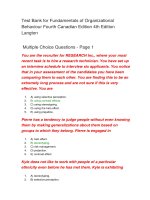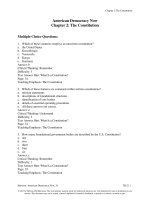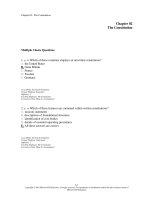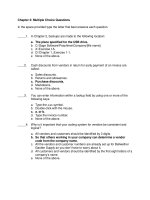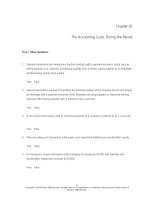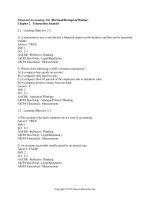Financial accounting fourth canadian edition 4th edition harrison test bank
Bạn đang xem bản rút gọn của tài liệu. Xem và tải ngay bản đầy đủ của tài liệu tại đây (519.43 KB, 44 trang )
Financial Accounting, Cdn. 4e (Harrison)
Chapter 2 Processing Accounting Information
1) All of the following accounts would be considered assets except for:
A) Cash
B) Common Shares
C) Prepaid Expenses
D) Notes Receivable
Answer: B
Diff: 2
Type: MC
2) The payment of an amount owed to a creditor would:
A) increase assets
B) increase liabilities
C) decrease net income
D) decrease liabilities
Answer: D
Diff: 2
Type: MC
3) When a company performs a service and immediately collects the cash from the customer, which of the
following would occur?
A) net income would increase
B) expenses would decrease
C) assets would decrease
D) shareholders' equity would decrease
Answer: A
Diff: 2
Type: MC
4) Purchasing supplies and paying cash for them would:
A) increase total assets
B) decrease total assets
C) have no effect on total assets
D) increase total liabilities and shareholders' equity
Answer: C
Diff: 2
Type: MC
5) Paying a utility bill would:
A) increase expenses
B) increase liabilities
C) increase owners' equity
D) decrease revenues
Answer: A
Diff: 2
Type: MC
1
© 2012 Pearson Canada Inc.
6) Borrowing money from the bank by signing a note payable would:
A) increase shareholders' equity
B) increase net income
C) decrease liabilities
D) have no effect on shareholders' equity
Answer: D
Diff: 2
Type: MC
7) Receiving a payment from a customer on account would:
A) have no effect on shareholders' equity
B) increase net income
C) increase shareholders' equity
D) increase liabilities
Answer: A
Diff: 2
Type: MC
8) The purchase of land for cash would:
A) increase total assets
B) decrease shareholders' equity
C) increase the total debits on the trial balance
D) not affect the total of debits or credits on the trial balance
Answer: D
Diff: 3
Type: MC
9) An owner investment of a building, valued at $100,000 with an $80,000 outstanding mortgage,
transferring this asset into the business would:
A) increase assets by $20,000
B) increase assets by $80,000
C) increase shareholders' equity by $20,000
D) increase shareholders' equity by $100,000
Answer: C
Diff: 3
Type: MC
10) Performing services on account would:
A) increase assets and liabilities
B) increase assets and decrease shareholders' equity
C) increase revenue and decrease shareholders' equity
D) increase net income and shareholders' equity
Answer: D
Diff: 3
Type: MC
11) The collection of cash from a customer on account would:
A) increase net income and shareholders' equity
B) increase assets and decrease liabilities
C) increase assets and increase net income
D) have no effect on net income or shareholders' equity
Answer: D
Diff: 3
Type: MC
2
© 2012 Pearson Canada Inc.
12) Dividends paid to the shareholders will:
A) increase assets and decrease liabilities
B) decrease assets and increase liabilities
C) have no effect on shareholders' equity
D) decrease assets and decrease shareholders' equity
Answer: D
Diff: 3
Type: MC
13) What type of account is Prepaid Rent?
A) a liability
B) an expense
C) shareholders' equity
D) an asset
Answer: D
Diff: 2
Type: MC
14) All of the following accounts are standard components of shareholders' equity except:
A) revenues
B) dividends
C) assets
D) expenses
Answer: C
Diff: 2
Type: MC
15) The costs of operating a business are usually called:
A) expenses
B) liabilities
C) assets
D) revenues
Answer: A
Diff: 1
Type: MC
16) Note payable, accounts payable, and salary payable are all examples of:
A) assets
B) revenue
C) expenses
D) liabilities
Answer: D
Diff: 1
Type: MC
17) Which of the following business events may not be recorded in a company's accounting records?
A) The company paid each of its employees a Christmas bonus.
B) The company issued 100 shares of common stock.
C) The company purchased two acres of land for future plant expansion.
D) A lawsuit has been filed by one of the company's customers (against the company).
Answer: D
Diff: 2
Type: MC
3
© 2012 Pearson Canada Inc.
18) The right side of a T-account is always the:
A) increase side
B) credit side
C) debit side
D) decrease side
Answer: B
Diff: 1
Type: MC
19) The entry to record the purchase of supplies on account would include a:
A) credit to the Accounts Payable account
B) debit to the Retained Earnings account
C) credit to the Cash account
D) credit to the Supplies account
Answer: A
Diff: 2
Type: MC
20) Credits to revenue accounts ultimately result in:
A) a decrease in owners' equity
B) an increase in owners' equity
C) a decrease in assets
D) an increase in liabilities
Answer: B
Diff: 2
Type: MC
21) The purchase of office equipment for cash would include a:
A) debit to Cash
B) debit to Office Equipment
C) credit to Accounts Payable
D) credit to Office Equipment
Answer: B
Diff: 2
Type: MC
22) An owner makes an investment of cash into the business. Such a transaction would include a:
A) debit to Common shares
B) credit to Cash
C) debit to Cash
D) debit to Accounts Receivable
Answer: C
Diff: 2
Type: MC
23) A business purchases a truck by signing a note payable to the seller. Such a transaction would include
a:
A) credit to Truck
B) debit to Note Payable
C) credit to Note Payable
D) debit to an expense account
Answer: C
Diff: 2
Type: MC
4
© 2012 Pearson Canada Inc.
24) The accounting transaction to record payment of the heating bill would include a:
A) debit to Cash
B) credit to Accounts Payable
C) debit to Utilities Expense
D) debit to Accounts Receivable
Answer: C
Diff: 2
Type: MC
25) The accounting transaction to record payment of the advertising bill would include a:
A) debit to Cash
B) credit to Accounts Payable
C) debit to Advertising Expense
D) debit to Accounts Receivable
Answer: C
Diff: 2
Type: MC
26) The accounting transaction to record payment of the telephone bill would include a:
A) credit to Cash
B) credit to Accounts Payable
C) credit to Utilities Expense
D) debit to Accounts Receivable
Answer: A
Diff: 2
Type: MC
27) The accounting transaction to record the payment of salaries to employees would include a:
A) credit to Salary Expense
B) debit to Accounts Payable
C) debit to Salary Expense
D) debit to Cash
Answer: C
Diff: 2
Type: MC
28) An owner's investment of land and a building into the business would include a:
A) debit to Land and a credit to Common shares
B) debit to Land and a credit to Building
C) debit to Common shares and a credit to Building
D) debit to Building and a debit to Common shares
Answer: A
Diff: 3
Type: MC
29) The purchase of an automobile with a cash down payment and a written promise to pay the balance
in the future would include a:
A) credit to Cash and a credit to Note Payable
B) debit to Cash and a credit to Automobile
C) debit to Note Payable and a credit to Cash
D) debit to Cash and a debit to Note Payable
Answer: A
Diff: 2
Type: MC
5
© 2012 Pearson Canada Inc.
30) The purchase of a building with a cash down payment and a written promise to pay the balance in the
future would include a:
A) credit to Cash and a credit to Note Payable
B) debit to Cash and a credit to Buildings
C) debit to Note Payable and a credit to Cash
D) debit to Cash and a debit to Note Payable
Answer: A
Diff: 2
Type: MC
31) Paying a dividend to the company's shareholders would include a:
A) debit to Cash and a credit to Dividends
B) debit to Dividends and a credit to Cash
C) debit to Retained Earnings and a credit to Dividends
D) debit to Accounts Payable and a credit to Retained Earnings
Answer: B
Diff: 2
Type: MC
32) Receiving a cheque from a customer on account would include a:
A) debit to Accounts Receivable and a credit to Cash
B) debit to Cash and a credit to Accounts Payable
C) debit to Accounts Payable and a credit to Cash
D) debit to Cash and a credit to Accounts Receivable
Answer: D
Diff: 3
Type: MC
33) Receiving cash from a customer on account would include a:
A) debit to Accounts Receivable and a credit to Cash
B) debit to Cash and a credit to Accounts Payable
C) debit to Accounts Payable and a credit to Cash
D) debit to Cash and a credit to Accounts Receivable
Answer: D
Diff: 3
Type: MC
34) Making a cash payment to settle a debt would include a:
A) debit to Cash and a credit to Accounts Receivable
B) debit to Accounts Receivable and a credit to Cash
C) debit to Accounts Payable and a credit to Cash
D) debit to Accounts Payable and a credit to Accounts Receivable
Answer: C
Diff: 3
Type: MC
35) Sending out a cheque to settle a debt would include a:
A) debit to Cash and a credit to Accounts Receivable
B) debit to Accounts Receivable and a credit to Cash
C) debit to Accounts Payable and a credit to Cash
D) debit to Accounts Payable and a credit to Accounts Receivable
Answer: C
Diff: 3
Type: MC
6
© 2012 Pearson Canada Inc.
36) Performing a service on account would include a:
A) debit to Cash
B) debit to Revenue
C) credit to Accounts Receivable
D) debit to Accounts Receivable
Answer: D
Diff: 2
Type: MC
37) Purchasing a three-year insurance policy for cash would include a:
A) debit to Cash and a credit to Accounts Receivable
B) debit to Insurance Expense and a credit to Dividends
C) debit to Prepaid Insurance and a credit to Accounts Payable
D) debit to Prepaid Insurance and a credit to Cash
Answer: D
Diff: 3
Type: MC
38) The payment for rent of the office building for one month would include a:
A) debit to Cash
B) credit to Accounts Payable
C) debit to Rent Expense
D) credit to Revenue
Answer: C
Diff: 2
Type: MC
39) The purchase of office furniture on account (that is, on credit) would include a:
A) credit to Accounts Payable
B) credit to Office Furniture
C) debit to Accounts Receivable
D) credit to Cash
Answer: A
Diff: 2
Type: MC
40) Which of the following statements regarding accounts is false?
A) An asset is increased by a debit and decreased by a credit.
B) Revenue is increased by a debit and an expense is increased by a credit.
C) A liability is decreased by a debit and increased by a credit.
D) Revenue is increased by a credit and an expense is increased by a debit.
Answer: B
Diff: 3
Type: MC
41) Which of the following statements regarding accounts is true?
A) Assets are decreased by debits.
B) Expenses are decreased by debits.
C) Revenues are increased by debits.
D) Liabilities are decreased by debits.
Answer: D
Diff: 3
Type: MC
7
© 2012 Pearson Canada Inc.
42) Which of the following accounts normally has a debit balance?
A) Dividends
B) Retained Earnings
C) Share capital
D) Revenue
Answer: A
Diff: 2
Type: MC
43) The account credited when supplies are purchased on account is:
A) Cash
B) Supplies
C) Supplies Expense
D) Accounts Payable
Answer: D
Diff: 2
Type: MC
44) When the owner of a business invests cash into the business, which of the following accounts is
debited?
A) Dividends
B) Cash
C) Common Shares
D) Accounts Receivable
Answer: B
Diff: 2
Type: MC
45) When a business sells inventory in exchange for cash, which of the following accounts is credited?
A) Revenue
B) Cash
C) Owners' Equity
D) Accounts Payable
Answer: A
Diff: 3
Type: MC
46) The account credited when cash is received from a customer on account is:
A) Cash
B) Accounts Payable
C) Revenue
D) Accounts Receivable
Answer: D
Diff: 2
Type: MC
47) A debit increases the balance of which types of accounts?
A) assets and liabilities
B) assets and expenses
C) liabilities and expenses
D) assets and shareholders' equity
Answer: B
Diff: 2
Type: MC
8
© 2012 Pearson Canada Inc.
48) A credit decreases the balance of which types of accounts?
A) expenses and assets
B) liabilities and expenses
C) assets and liabilities
D) assets and shareholders' equity
Answer: A
Diff: 2
Type: MC
49) A credit increases the balance of which types of accounts?
A) revenue and assets
B) liabilities and assets
C) liabilities and expenses
D) shareholders' equity and liabilities
Answer: D
Diff: 2
Type: MC
50) Which type of account is credited when a company pays its employees?
A) an expense account
B) an asset account
C) a liability account
D) the owner's equity account
Answer: B
Diff: 2
Type: MC
51) Which type of account is credited when a company records a debt?
A) expense
B) retained earnings
C) liability
D) asset
Answer: C
Diff: 2
Type: MC
52) When a company purchases inventory on account (that is, on credit), which type of account is
credited to record the transaction?
A) asset
B) expense
C) liability
D) owners' equity
Answer: C
Diff: 2
Type: MC
53) The basic summary device of accounting is better known as the:
A) transactions
B) journal
C) account
D) financial statements
Answer: C
Diff: 2
Type: MC
9
© 2012 Pearson Canada Inc.
54) The accounting process of copying of amounts from the journal to the appropriate ledger accounts is
referred to as:
A) journalizing
B) footing
C) balancing
D) posting
Answer: D
Diff: 1
Type: MC
55) Which of the following items of information would not normally be included in a journal entry?
A) the date the transaction took place
B) the dollar amount of the debit
C) the title of the account debited
D) the location where the transaction took place
Answer: D
Diff: 2
Type: MC
56) Which element of an accounting system provides information about the balance in each account?
A) source documents
B) journals
C) ledgers
D) cash flow statement
Answer: C
Diff: 2
Type: MC
57) In accounting, the process of posting is:
A) copying data from the ledger to the journal
B) copying data from the journal to the ledger
C) copying data from the source documents to the ledger
D) copying data from the source documents to the journal
Answer: B
Diff: 2
Type: MC
58) The payment of the owner's personal expenses from the business's chequebook should be recorded
with a debit to:
A) Cash
B) Dividends
C) Common shares
D) Accounts Receivable
Answer: B
Diff: 2
Type: MC
59) The payment of salaries to employees would:
A) increase assets
B) increase net income
C) increase liabilities
D) decrease shareholders' equity
Answer: D
Diff: 2
Type: MC
10
© 2012 Pearson Canada Inc.
60) Posting, a part of the accounting process, refers to:
A) copying amounts from the accounts in the general ledger to the journal
B) copying amounts from the financial statements to the general ledger
C) copying amounts from the journal to the appropriate accounts in the general ledger
D) copying amounts from the general ledger to the financial statements
Answer: C
Diff: 1
Type: MC
61) Accounting transactions are first recorded in a book or record called a:
A) file
B) ledger
C) journal
D) source document
Answer: C
Diff: 1
Type: MC
62) A chronological record (or history) of an entity's transactions is called a(n):
A) journal
B) account
C) source document
D) ledger
Answer: A
Diff: 1
Type: MC
63) What is the first step in the journalizing process?
A) Enter the transaction in the journal.
B) Identify the transaction from source documents and other information.
C) Determine what accounts will be affected and whether to debit or credit them.
D) Post the transaction to the ledger.
Answer: B
Diff: 2
Type: MC
64) Which of the following items would not be included in the journal entry for a transaction?
A) the names of the source documents used to record the accounting transaction
B) the titles of the accounts that will be used as debits and credits in the transaction
C) the date the accounting transaction was entered into the accounting system
D) the dollar amounts used to record the debits and credits in the transaction
Answer: A
Diff: 1
Type: MC
11
© 2012 Pearson Canada Inc.
65) The entry to record the purchase of office supplies for $100 cash would be:
A) Office Supplies
100
Cash
100
B) Accounts Payable
100
Cash
100
C) Office Supplies
100
Accounts Payable
100
D) Cash
100
Office Supplies Expense
100
Answer: A
Diff: 1
Type: MC
66) The entry to record an owner investment of $500 into the business would be:
A) Dividends
500
Cash
500
B) Cash
500
Dividends
500
C) Cash
500
Service Revenue
500
D) Cash
500
Common Shares
500
Answer: D
Diff: 1
Type: MC
67) The entry to record an owner investment of $1500 into the business including a $500 piece of
equipment would be:
A) Dividends
1500
Equipment
500
Cash
1000
B) Cash
1500
Dividends
1500
C) Cash
1500
Service Revenue
1000
Equipment
500
D) Cash
1000
Equipment
500
Common Shares
1500
Answer: D
Diff: 1
Type: MC
12
© 2012 Pearson Canada Inc.
68) The entry to record the payment of $895 salary to employees would be:
A) Cash
895
Salary Payable
895
B) Dividends
895
Cash
895
C) Salary Expense
895
Cash
895
D) Salary Expense
895
Retained Earnings
895
Answer: C
Diff: 1
Type: MC
69) The entry to record $500 received from a customer for services rendered to that customer would be:
A) Cash
500
Accounts Receivable
500
B) Cash
500
Service Revenue
500
C) Service Revenue
500
Accounts Receivable
500
D) Dividends
500
Cash
500
Answer: B
Diff: 1
Type: MC
70) This summarizes all the account balances for the financial statements and shows whether total debits
equals total credits:
A) ledger
B) trial balance
C) journal
D) accounting equation
Answer: B
Diff: 1
Type: MC
71) The normal balance of Accounts Receivable is a ________ because it is a(n) ________ account.
A) credit, liability
B) debit, expense
C) credit, shareholders' equity
D) debit, asset
Answer: D
Diff: 2
Type: MC
72) The normal balance of the Supplies account is a ________ because it is a(n) ________ account.
A) credit, liability
B) debit, asset
C) credit, expense
D) debit, shareholders' equity
Answer: B
Diff: 2
Type: MC
13
© 2012 Pearson Canada Inc.
73) The normal balance of the Supplies account is a ________ because it is a(n) ________ account.
A) credit, liability
B) debit, asset
C) credit, expense
D) debit, shareholders' equity
Answer: B
Diff: 2
Type: MC
74) The normal balance of the Accounts Payable account is a ________ because it is a(n) ________ account.
A) debit, asset
B) credit, shareholders' equity
C) credit, liability
D) credit, revenue
Answer: C
Diff: 2
Type: MC
75) The normal balance of the Common Shares account is a ________ because it increases ________.
A) debit, assets
B) credit, shareholders' equity
C) credit, liabilities
D) debit, expenses
Answer: B
Diff: 2
Type: MC
76) The normal balance of an expense account is a ________ because expenses decrease ________.
A) credit, assets
B) debit, shareholders' equity
C) credit, liabilities
D) debit, revenues
Answer: B
Diff: 2
Type: MC
77) The normal balance of the Dividends account is a ________ because it decreases ________.
A) debit, shareholders' equity
B) debit, liabilities
C) debit, assets
D) credit, revenues
Answer: A
Diff: 2
Type: MC
78) The normal balance of a revenue account is a ________ because revenues increase ________.
A) debit, assets
B) debit, dividends
C) credit, liabilities
D) credit, shareholders' equity
Answer: D
Diff: 2
Type: MC
14
© 2012 Pearson Canada Inc.
79) A trial balance is:
A) prepared before the posting process is completed
B) a list of income statement accounts with their balances
C) a list of balance sheet accounts with their balances
D) a list of all accounts with their balances
Answer: D
Diff: 2
Type: MC
80) A trial balance is a useful device because it provides a check on accuracy by showing whether:
A) total assets equal total liabilities
B) total debits equal total credits
C) total revenues plus gains equal total expenses plus losses
D) total of all the income statement accounts equals the total of all the balance sheet accounts
Answer: B
Diff: 2
Type: MC
81) If the debit amount of an entry to record the purchase of supplies on account was not posted:
A) liabilities would be understated
B) liabilities would be overstated
C) assets would be overstated
D) assets would be understated
Answer: D
Diff: 3
Type: MC
82) If a transposition error has occurred when recording a transaction, then the out-of-balance amount
will be evenly divisible by:
A) 11
B) 9
C) 2
D) 5
Answer: B
Diff: 2
Type: MC
83) If the credit amount of an entry to record the payment of salaries was not posted:
A) expenses would be understated
B) assets would be overstated
C) shareholders' equity would be understated
D) expenses would be overstated
Answer: B
Diff: 3
Type: MC
84) Which of the following statements regarding a trial balance is false?
A) A trial balance may be taken at any time the postings are up to date.
B) A trial balance is a list of all accounts with their balances.
C) A trial balance is the same as a balance sheet.
D) A trial balance provides a check on the equality of debits and credits.
Answer: C
Diff: 2
Type: MC
15
© 2012 Pearson Canada Inc.
85) A trial balance has all of the following features listed below except:
A) a heading
B) subtotals for assets, liabilities, and shareholders' equity
C) totals for both debits and credits
D) accounts listed in order, assets first, followed by liabilities and then shareholders' equity
Answer: B
Diff: 2
Type: MC
86) An organization's list of all its accounts and the related account numbers is called a:
A) journal
B) ledger
C) trial balance
D) chart of accounts
Answer: D
Diff: 1
Type: MC
87) A chart of accounts is:
A) prepared as the last step in analyzing transactions
B) a source document
C) the same as a trial balance
D) a list of all of the accounts of the organization and their related account numbers
Answer: D
Diff: 1
Type: MC
88) A trial balance that is "in balance" proves:
A) the equality of the debits and credits
B) all journal entries were properly posted to the ledger
C) all transactions were properly recorded during the accounting period
D) none of the above
Answer: A
Diff: 1
Type: MC
89) When using a three-column account format, the column on the far right is used to show:
A) the debit and credit amounts posted from journal entries
B) the names of the accounts being debited and credited
C) the transactions' date and journal reference
D) the account's balance
Answer: D
Diff: 3
Type: MC
90) A chart of accounts is:
A) a list of all accounts
B) a list of all balance sheet accounts
C) a list of all income statement accounts
D) a list of all accounts with their ending balances
Answer: A
Diff: 1
Type: MC
16
© 2012 Pearson Canada Inc.
91) The normal balance of a liability account is a ________ and the normal balance of the common shares
account is a ________.
A) debit, credit
B) debit, debit
C) credit, debit
D) credit, credit
Answer: D
Diff: 2
Type: MC
92) Which of the following accounts does not have a normal credit balance?
A) Retained Earnings
B) Common Shares
C) Accounts Payable
D) Inventory
Answer: D
Diff: 2
Type: MC
93) The normal balance of an expense account is a ________ while the normal balance of a revenue
account is a ________.
A) debit, debit
B) credit, credit
C) credit, debit
D) debit, credit
Answer: D
Diff: 2
Type: MC
94) Certificates of deposit are classified as cash on the income statement.
Answer: FALSE
Diff: 2
Type: TF
95) A transaction involving the cash purchase of equipment will decrease one asset account and increase
another asset account.
Answer: TRUE
Diff: 2
Type: TF
96) A balance sheet is organized in order of the accounting equation, with liabilities first, followed by
assets and shareholders' equity.
Answer: FALSE
Diff: 1
Type: TF
97) A balance sheet is a required financial statement that reports the financial position of the company as
of a given day in time.
Answer: TRUE
Diff: 2
Type: TF
98) Notes Payable is a typical example of a liability account.
Answer: TRUE
Diff: 1
Type: TF
17
© 2012 Pearson Canada Inc.
99) The account called Accrued Liabilities is really an expense account and not a liability account.
Answer: FALSE
Diff: 1
Type: TF
100) The Dividends account represents the money invested by shareholders into the business since its
inception.
Answer: FALSE
Diff: 1
Type: TF
101) The purchase of office equipment on account would increase an asset and decrease a liability
account.
Answer: FALSE
Diff: 2
Type: TF
102) The left side of a T-account is always the side that increases the balance of the account.
Answer: FALSE
Diff: 1
Type: TF
103) The right side of a T-account is always the debit side.
Answer: FALSE
Diff: 1
Type: TF
104) Assets, owners' equity, and expenses are all increased by debits.
Answer: FALSE
Diff: 2
Type: TF
105) A credit always decreases an asset account.
Answer: TRUE
Diff: 2
Type: TF
106) Expenses increase shareholders equity. That is why they are credits.
Answer: FALSE
Diff: 2
Type: TF
107) A dividend account is known as a contra equity account.
Answer: TRUE
Diff: 2
Type: TF
108) An expense account is known as a contra equity account.
Answer: TRUE
Diff: 2
Type: TF
109) The purchase of office supplies for cash would include a debit to the asset Office Supplies and a credit
to the asset Cash.
Answer: TRUE
Diff: 2
Type: TF
110) Every accounting transaction involves an increase in at least one account and a decrease in at least
one other account.
Answer: FALSE
Diff: 2
Type: TF
18
© 2012 Pearson Canada Inc.
111) The purchase of a building with a down payment of cash and the signing of a note payable for the
remainder would include a debit to both the asset Building, and a credit to the asset Cash and the liability
Note Payable.
Answer: TRUE
Diff: 2
Type: TF
112) The Dividends account normally has a debit balance.
Answer: TRUE
Diff: 2
Type: TF
113) Every transaction affects at least two accounts.
Answer: TRUE
Diff: 1
Type: TF
114) The ledger provides a good indication of how much cash is available for the business to use.
Answer: TRUE
Diff: 2
Type: TF
115) Posting is the process of copying the amounts from the journal to the appropriate accounts in the
ledger.
Answer: TRUE
Diff: 1
Type: TF
116) A journal is a record of financial transactions and can be thought of as a diary; it shows a
chronological listing of a business's accounting activities.
Answer: TRUE
Diff: 1
Type: TF
117) Debits are always recorded (journalized) after credits.
Answer: FALSE
Diff: 2
Type: TF
118) A ledger is the first place where transactions are recorded in the accounting system.
Answer: FALSE
Diff: 1
Type: TF
119) Moving data to the ledger is known as journalizing.
Answer: FALSE
Diff: 1
Type: TF
120) In the journal you will find the total balance for each account.
Answer: FALSE
Diff: 1
Type: TF
121) When the trial balance is out of balance due to a slide-type error, the difference between total debits
and total credits will be evenly divisible by 9.
Answer: TRUE
Diff: 2
Type: TF
19
© 2012 Pearson Canada Inc.
122) When the trial balance is out of balance due to a transposition error, the difference between total
debits and total credits will be evenly divisible by 9.
Answer: TRUE
Diff: 2
Type: TF
123) A trial balance is a list of all of a company's accounts with their account numbers.
Answer: FALSE
Diff: 2
Type: TF
124) A trial balance is simply a list of all accounts and their balances at a point in time.
Answer: TRUE
Diff: 1
Type: TF
125) If a trial balance is in balance, the accountant is assured that no mistakes were made either in
recording or posting.
Answer: FALSE
Diff: 2
Type: TF
126) The trial balance is used to prepare the income statement.
Answer: TRUE
Diff: 2
Type: TF
127) On a trial balance the total of all debits must equal the total of all credits.
Answer: TRUE
Diff: 1
Type: TF
128) Accounts payable normally has a debit balance.
Answer: FALSE
Diff: 1
Type: TF
129) Accounts receivable normally has a credit balance.
Answer: FALSE
Diff: 1
Type: TF
130) The revenue account typically has a credit balance.
Answer: TRUE
Diff: 1
Type: TF
131) The trial balance is the starting point for preparing the organization's financial statements.
Answer: TRUE
Diff: 1
Type: TF
132) All revenue accounts normally have a credit balance.
Answer: TRUE
Diff: 1
Type: TF
133) All shareholders equity accounts typically have a credit balance except for dividends which are a
debit.
Answer: TRUE
Diff: 1
Type: TF
20
© 2012 Pearson Canada Inc.
134) On a trial balance the total of all debits must equal the total of all credits.
Answer: TRUE
Diff: 1
Type: TF
135) Total debits must always equal total credits in order for a trial balance to balance.
Answer: TRUE
Diff: 1
Type: TF
136) The normal balance for any account is always the side of the account (debit or credit) where
increases are recorded.
Answer: TRUE
Diff: 2
Type: TF
21
© 2012 Pearson Canada Inc.
137) Analyze the following transactions. Indicate which accounts are affected and whether they will
increase or decrease. Transaction (a) is completed as an example.
a. Owner investment of cash into the business.
b. Payment of a utility bill.
c. Purchase of inventory for cash.
d. Payment of an accounts payable.
e. Performing a service on account.
f. Collecting cash from a customer as payment on his account.
Transaction
a.
Accounts
Cash
Common
shares
Increase
x
Decrease
x
b.
c.
d.
e.
f.
Answer:
Transaction
a.
b.
c.
d.
e.
f.
Diff: 2
Accounts
Increase
Cash
x
Common
shares
x
Utility expense
x
Cash
Inventory
x
Cash
Accounts
Payable
Cash
Accounts
Receivable
x
Service
Revenue
x
Cash
x
Accounts
Receivable
Decrease
x
x
x
x
x
Type: ES
22
© 2012 Pearson Canada Inc.
138) Explain the following terms in your own words and give an example of each.
a. asset
b. liability
c. shareholder's equity
d. dividend
e. revenue
f. expense
Answer:
a. Assets are expected to provide economic benefits in the future by contributing to earning revenues.
Humpty uses a significant amount of machinery and equipment to manufacture its products.
b. A liability is an obligation to provide goods or services in the future. Some examples are accounts
payables and loans. Humpty borrows money (loan) from several sources including PEI business
development Inc.
c. Shareholders' equity is direct or indirect investment in an entity by its owners. Examples are common
shares and preferred shares. Humpty issues common shares and they trade on the Toronto Stock
Exchange under the symbol SNX.
d. Dividends are amounts paid to the owners from the earnings of the firm. Examples are common share
dividends and preferred dividends. As of January 2006, Humpty did not declare dividends.
e. Revenues are economic benefits earned by providing goods or services to customers. Examples are
sales and fees earned.
f. Expenses are costs incurred to earn revenue. Examples include cost of goods sold and wages.
Diff: 1
Type: ES
139) For each of the following independent scenarios, fill in the blanks with the appropriate dollar
amount.
Assets
- Liabilities = Shareholders' Equity
Scenario A $ 270,000
$
$ 75,000
Scenario B
600,000
1,500,000
Scenario C 450,000
400,000
Scenario D 410,000
95,000
Answer:
Assets
Liabilities
=
Shareholders' Equity
Scenario A $ 270,000
$ 195,000
$ 75,000
Scenario B 2,100,000
600,000
1,500,000
Scenario C 450,000
400,000
50,000
Scenario D 410,000
315,000
95,000
Diff: 1
Type: ES
23
© 2012 Pearson Canada Inc.
140) Slick Corporation has summarized financial statements as shown below. Fill in the blank areas to
complete the financial statements. Begin in 2009 and move forward from there.
Slick Corporation
For the Year Ended June 30
2011
Revenues
Expenses
Net Income
Retained Earnings beginning
Dividends declared
Retained earnings end
Common Shares end
Liabilities end
Assets end
Answer:
$
1,470,000
130,000
2010
$2,100,000
1,430,000
2009
$2,500,000
550,000
0
336,000
350,000
200,000
830,000
50,000
250,000
250,000
180,000
430,000
Slick Corporation
For the Year Ended June 30
Revenues
Expenses
Net Income
Retained Earnings beginning
Dividends declared
Retained earnings end
Common Shares end
Liabilities end
Assets end
Diff: 2
2011
$1,600,000
2010
2009
1,950,000
384,000
164,000
670,000
50,000
500,000
384,000
280,000
130,000
830,000
814,000
Type: ES
24
© 2012 Pearson Canada Inc.
141) The following is a summary of the balance sheet accounts for Betty's Bacon Inc. Organize the
accounts into Betty's Bacon's Balance Sheet.
Accounts Payable
Inventory
Prepaid Insurance
Common Shares
Furniture and Fixtures
Bank loan
Answer:
37,500
42,500
5,000
75,000
125,000
44,000
Land
Salary Payable
Tax Payable
Accounts Receivable
Retained Earnings
Cash
62,500
12,000
50,000
17,500
40,000
6,000
Betty's Bacon Inc.
Balance Sheet
Cash
Accounts Receivable
Inventory
Prepaid Insurance
Land
Furniture and Fixtures
Total assets
Diff: 1
$6,000
17,500
42,500
5,000
62,500
125,000
$258,500
Bank loan
Accounts Payable
Salary Payable
Tax Payable
$44,000
37,500
12,000
50,000
Retained Earnings
Common Shares
40,000
75,000
Total liabilities
and equity
$258,500
Type: ES
142) Prepare a Statement of Retained Earnings for the year ended June 30, 2011.
Chedacorn was incorporated on July 1, 2009 by 10 shareholders who each invested $100,000 in cash in
exchange for common shares. Chedacorn's year end is June 30th. In its first year of business chedacorn
had a net income of $243,750. For its years ended June 30, 2010 and 2011, its second and third years of
operation, Chedacorn reported net income of $472,500 and $560,000 respectively. In its first year
Chedacorn did not pay any dividends, but in fiscal 2010 it paid $62,500 in dividends and in 2011 it paid
$100,000 in dividends.
Answer:
Chedacorn Corporation
Statement of Retained Earnings
For the year ended June 30, 2011
Retained Earnings, July 1, 2010
Net income for the year
Less dividends
Retained Earnings, June 30, 2011
$ 653,750
560,000
(100,000)
$ 1,113,750
Note: To solve the exercise, retained earnings on July 1, 2010 must be calculated. This amount is $243,750
+ $472,500 - $62,500.
Diff: 1
Type: ES
25
© 2012 Pearson Canada Inc.
